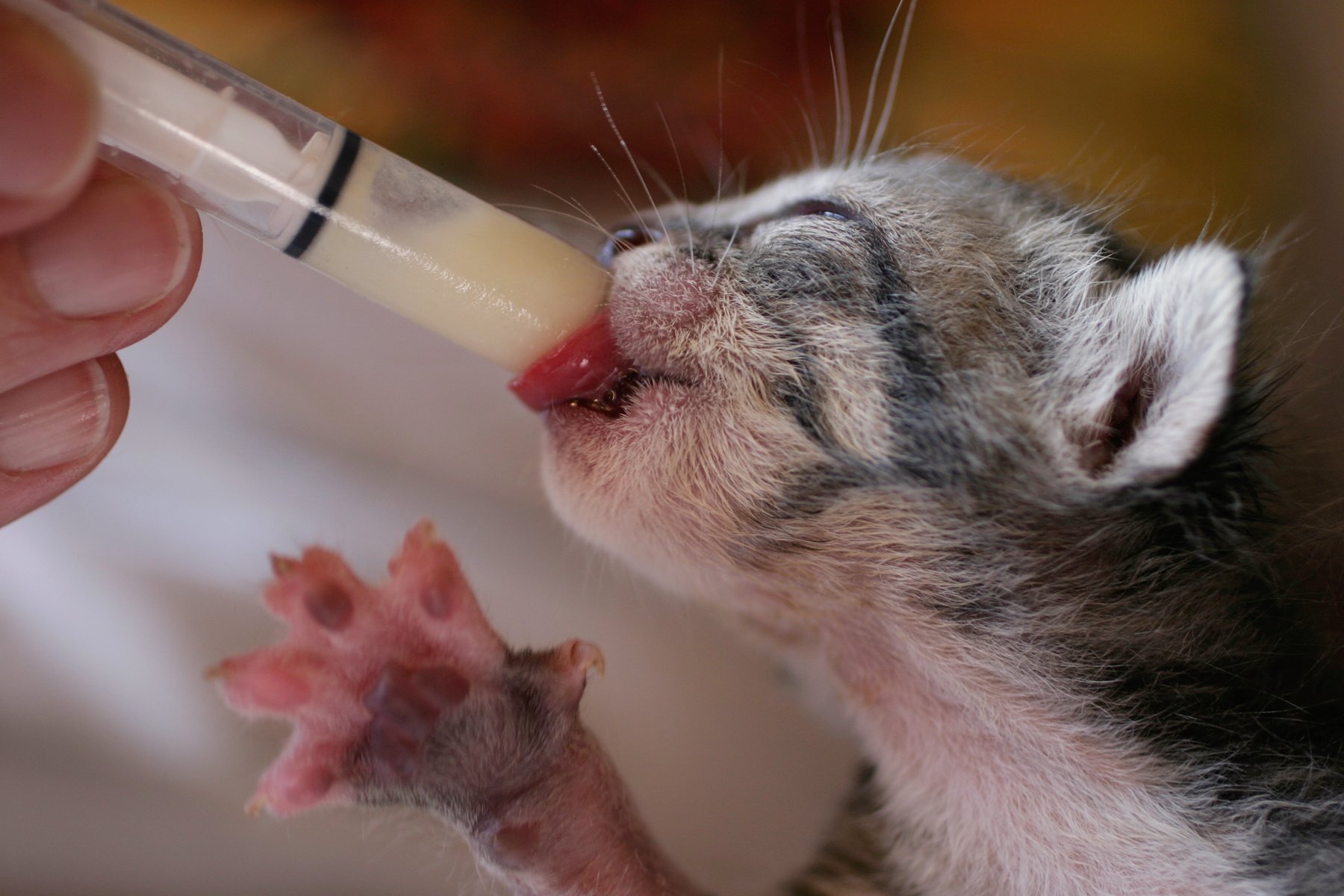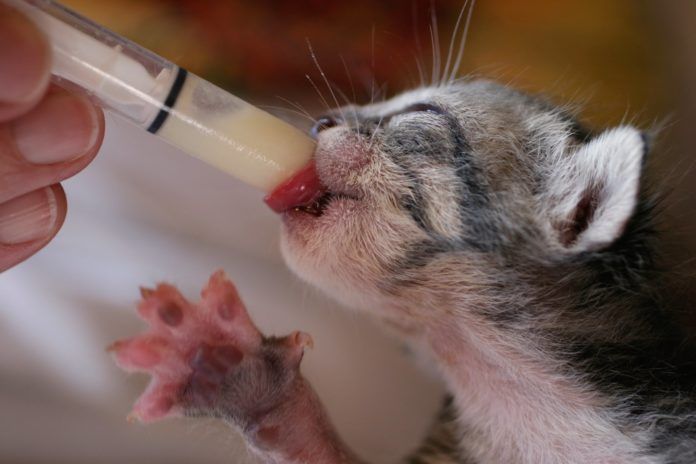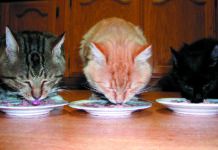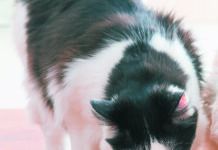© yoglimogli/Getty Images


Something didn’t seem right,” recalls Kim Feild of Montgomery, Texas. The kittens she and her children had brought home from an animal shelter were surprisingly small for their stated three months of age. And alarmingly, one of them had taken to sleeping in a quirky way, head thrown back, body straight up. Mrs. Feild’s husband, Marc, drove that kitten to the shelter to see a veterinarian, but it died en route. It was heartbreaking because her son, Cody, had picked out the cat and had already named it Cottonball.
It dawned on Mrs. Feild that the kittens were so tiny — and vulnerable — because they may not yet have reached their stated age of three months. That meant they were likely not fully weaned and had been unable to get the nutrition they needed from the kibble she had been providing them. Once she swapped out solid kitten food for kitten’s milk, the surviving pet, aptly named “Small Fry” by her daughter Samantha, thrived.
When things go as they should
Proper kitten feeding is usually a fairly straightforward process. “Basically, once a litter is fully weaned by eight to 10 weeks of age, you just need a food formulated for kitten growth until a year of age, adjusting the amounts after spaying or neutering to prevent excessive weight gain,” says Cummings School veterinary nutritionist Cailin Heinze, VMD.
If you have taken home a kitten at the post-10-week stage, you might want to try canned food formulated for kittens, as this is easier for them to manage with their baby teeth, with a bowl of dry kibble to the side. But make sure that the food is appropriate to your kitten’s life stage and is not intended for an older cat. “I see people feeding food not meant for kittens, especially canned foods, relatively frequently,” says Dr. Heinze.
To make sure that the food you are providing will meet the appropriate standards for nutrition, Dr. Heinze recommends that you look for the American Association of Feed Control Officials (AAFCO) nutritional adequacy statement on whatever kitten food you purchase. You may have to search a bit to find the small print on either the back of the bag or can or on the fold that is on the side of the bag. But this statement lets you know that the work has been done for you, and that the diet meets nutrient needs specific to your pet’s life stage.
In the AAFCO statement, you want to look for the words “for growth” or “for all life stages.” Those two terms mean the food is appropriate for kittens. If it says “maintenance,” that means the food is right only for adult cats — not for a cat younger than a year. If the AAFCO statement says the food actually went through animal feeding trials, that provides more assurance of its adequacy than the words has been “formulated to meet” the needs for growth (or for all life stages). But either is okay if the food is made by a reputable company that practices excellent quality control and includes a board-certified veterinary nutritionist or someone with a doctorate in animal nutrition on staff. (You can call the company to ask.)
Offer different types of food
Besides providing a nutritionally balanced food appropriate for kitten growth, always served with a bowl of fresh clean water to the side, you may also want to offer some choices in diet initially. “To help prevent finicky behavior down the line, you may want to feed your kitten a variety of textures of food — different shapes of dry, different textures of canned in the first few months, provided this doesn’t cause GI upset,” says Dr. Heinze. “After kittens are about four months or so, it can be harder to get them to eat new foods.”
Kittens younger than four months of age can be fed free choice (keep in mind that canned food should not be left out for more than one to two hours to prevent bacterial growth). But as their growth starts to slow down or around the time of spay or neuter, they should be transitioned to meal feeding with measured amounts. Free-choice feeding is a strong risk factor for obesity in adult cats.
When issues arise
From birth through the first two to three months, a kitten’s nutrition needs are met with milk from her mother unless — as the case above illustrates — something goes awry. Some key reasons to bottle feed would be an orphaned kitten, a kitten taken away from her mother too soon, or a situation in which the mother cat is not producing enough milk, causing the kittens to lose weight when they should be gaining. In these cases, “kittens should be provided with a commercially available formula specifically made for them rather than a more multi-purpose formula that would cover other small animals,” Dr. Heinze says. The wrong formula can cause GI upset, failure to gain weight and even serious diarrhea.
“Homemade solutions should not be used, and there is no need to experiment with them, anyway, since kitten formula can be purchased in any pet supply store,” explains Dr. Heinze.
If you keep track of a kitten’s weight, you will be able to accurately recognize if she is failing to grow and thrive. Generally, kittens begin life at 3.5 ounces (100 grams) and then gain up to 0.25 to 0.35 ounces (7 to 10 grams) per day during the course of their first year. In their first week, kittens will consume about 13 milliliters of formula per 100 grams of body weight. Break this up into several feedings of formula every two to three hours during the day and every three to four hours at night.
Around one to two weeks, space feedings out to every four to six hours. Don’t try to feed too much as this can cause GI upset. The stomach should not appear distended after a feeding. If you are not seeing a steady rate of growth, it is likely time to take your kitten to the veterinarian.
When bottle-feeding your kitten, it is important to have the appropriate bottle and nipple size to provide the formula without causing choking or indigestion.
Never feed a cold, debilitated kitten as this will interfere with digestion and can make things worse. The kitten should be warm — with a normal body temperature — prior to feeding. Place the kitten securely on your lap while holding her head with your forefinger and thumb, gently maintaining a hold that prevents head movement — you don’t want the nipple to keep slipping from her mouth.
Use the same gentle pressure when squeezing the bottle so that only a drop of formula comes to the nipple tip. At first, your kitten may chew on the nipple rather than suckle, but she will figure out how to draw formula in due time.
To make sure that a bit of air gets into the bottle to allow flow, either remove the bottle from your nursing kitten when she appears to lose interest in feeding and loosen the lid to see if that makes it easier for her to suckle, or start out with the lid slightly loosened.
Emotional comfort is an additional benefit to feeding time — keep it calm and cuddly. Very soon, your kitten will want to knead, just as she would if nursing from her mother. Kittens do this alternating paw movement at first to stimulate the flow of milk from their mother’s nipple, but the behavior sometimes continues as they grow and often occurs when your cat is happy, demonstrated by purring while kneading you, blankets or a favorite cushion.
An important note: If you’re dealing with a litter, make sure to feed each kitten separately and away from the other kittens, who will likely vie for their own chance for a feeding. It is also very important to keep track of weights of every kitten to make sure they are all getting enough.
Feeding tools you’ll need
A “baby bottle,” such as a PetAg Nurser for kittens or other small animals, is ideal for feeding. But if you are unable to find that particular bottle type, you can ask for assistance from a pet store. If there is nothing available along those lines, you can try a 3-cc syringe, which is not quite as good because it does not allow suckling and the modulation of how much formula is ingested. The kitten just has to deal with the amount you squirt in.
Do take care if using a syringe because too much formula at once can cause your kitten to inhale the formula into its lungs, which can cause pneumonia. And do not allow the syringe to become the only means of feeding. Though it may take some time and effort, it’s important to switch your kitten to a bottle when ready because suckling is an important part of the process of learning to eat solid foods down the line.
On the off chance that you have a kitten too weak to suckle or deal with food squirted slowly into her mouth with a syringe, you might want to try an eye dropper with some formula sitting at the tip. Another option, which should be demonstrated by your veterinarian or a veterinary technician during an office visit, is tube feeding. Never try tube feeding on your own unless you are experienced because aspiration pneumonia (an infection from inhaling formula into the lungs) is a common and potentially fatal condition for inexperienced tube feeders.
Raising a kitten is such an enjoyable experience. Providing her with food appropriate to her specific stage in life will give your kitten the best chance for a healthy life ahead. — Constance Lindner




